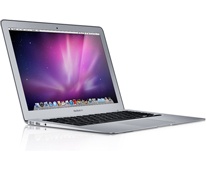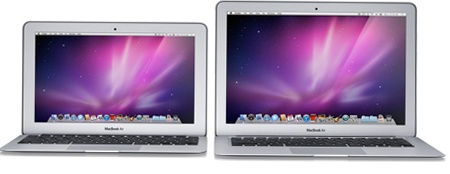New MacBook Air Becoming Even More Flash
Chris Hadley / 14 years ago

After hints for some time that a new redesigned MacBook Air was on the way, last night Steve Jobs – CEO at Apple, revealed the companies lightest and thinnest MacBook to date.
The new Air is to come in two variants. The smaller 11.6″ features a 1366 x 768 LED backed screen – remember that to get this resolution with the current Air you need a minimum of the 15″ screen, so there’s another vast improvement straight off, and the bigger brother of the two will size in at 13.3″ packing a 1440×900 resolution out of its ultra thin LED screen.
Its not just the screen that is amazingly thin. Both models are no more than 1.7cm thick when closed and to beat that, they’re only 0.3cm at the thinnest point! They’re also light as a feather, the 11″ is only a mere 1.06Kg and the 13″ just tips the scales at 1.32Kg.
Both laptops will come with 2Gb of DDR3 RAM (upgradeable to 4Gb) and a NVIDIA GeForce 320M GPU with 256Mb of DDR3 SDRAM shared also with its main memory. The 11″ comes with an Intel Core 2 Duo processor at 1.4GHz 3Mb L2 Cache and 800MHz FSB or the option of a 1.6GHz variant, the larger 13″ has a 1.86GHz Core 2 Duo with 6Mb L2 Cache and 1066MHz FSB, or a 2.13GHz option.
The most notable change with the new Air compared to the old is the lack of a hard drive entirely. The new Air is only available with a Solid State Drive ranging from 64Gb & 128Gb in the 11″ to 128Gb & 256Gb in the 13″. We already know SSD to be an expensive option on the current air but Steve Jobs has already hinted that Apple is planning to eventually make solid state drives the standard for notebooks.

So what are the pro’s and con’s of these new drives over the current standard?
These new drives have no moving parts which has a number of advantages in its own right. The drives do not need to spin up from standby to access data, which now allows for the almost instant-on experience from standby like we currently have with the iPad. The drives are also drastically smaller than a traditional drive, which means less space is needed in the case and also no caddies or cages are needed to mount them in as they attach directly to the motherboard.
The drives are also more robust, because there are no moving parts, they are more resilient to shock and vibration meaning that there is less of a chance of data loss or corruption due to knocking the drive during use/transit.
The drives also run a lot cooler as there are no moving parts to generate heat, contrary to this there are no fans as Jobs likes quiet machines, although we’ll see if the new chassis design has sorted out the cooling problems that was found on the original Air.
On the flip side though flash drives do have their drawbacks, mainly their cost. Per Gb you’re going to find more Gb per £ in a traditional hard drive than you will in a Solid State Drive for a while to come, but this is to be part expected with new technologies.
This bang per buck approach is therefore noticeable in the prices for the new Air. With the 11″ you’ll either pay £849 for 64Gb of space of £999 for 128Gb. similarly on the 13″ £1099 will get you 128Gb of space and £1349 will supply 256Gb.

So with the prices in mind, what other features will you be seeing for the price tag?
With the 11″ you’ll be getting a healthy 5 hours of battery life and 7 hours on the larger 13″ – although this is not as much as the MacBook Pros battery life, we do have to remember that a smaller chassis means a smaller battery, but this is where the SSD has its advantage, because the new Air draws less power, it can harvest more life per ratio of battery space. Both now allow for a standby time of up-to a month with the almost instant awakening – this feature taken from the iPad.
You’ll also be getting wireless 802.11 a/b/g/n connectivity and Bluetooth 2.1 with EDR (Enhanced Data Rate), plus 2 USB 2.0 ports (although I’d personally like to have seen at least one 3.0 compatible port), a mini-display port, headphone port, built in microphone on the side and the standard magsafe connector for power. The 13″ model also has an SD card reader built in.
Obviously we’re not going to get an optical drive as expected from the features of the current Air but plugging in a drive or using a shared drive from another PC or Mac solves this. The other feature that I’ve noticed that was missing was the availability of Ethernet connectivity. I personally would rather have this this in as shifting large amounts of data over wifi whether it be g or n can be quite time consuming although buying a 3rd party USB to LAN adaptor may solve this.
Due to the fact that there is no optical drive, Apple is including a USB recovery key should you need to reformat and install OSX when there is not optical drive nearby for use.
Whilst the overall specs are not the most performance breaking, this shows that Apple are taking a step back in order to make a bigger step forward in laptop design and practicality.
What do you think of the new release from Apple? Air you views below or over on the forums at eTeknix.com



















